First FDA Authorization for Next-Generation Sequencer
- 格式:pdf
- 大小:425.69 KB
- 文档页数:3
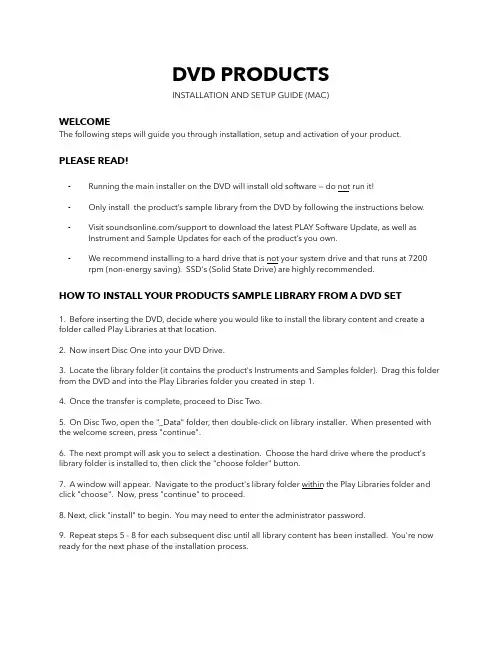
DVD PRODUCTSINSTALLATION AND SETUP GUIDE (MAC)WELCOMEThe following steps will guide you through installation, setup and activation of your product. PLEASE READ!⁃Running the main installer on the DVD will install old software — do not run it!⁃Only install the product’s sample library from the DVD by following the instructions below.⁃Visit /support to download the latest PLAY Software Update, as well as Instrument and Sample Updates for each of the product’s you own.⁃We recommend installing to a hard drive that is not your system drive and that runs at 7200 rpm (non-energy saving). SSD's (Solid State Drive) are highly recommended.HOW TO INSTALL YOUR PRODUCTS SAMPLE LIBRARY FROM A DVD SET1. Before inserting the DVD, decide where you would like to install the library content and create a folder called Play Libraries at that location.2. Now insert Disc One into your DVD Drive.3. Locate the library folder (it contains the product's Instruments and Samples folder). Drag this folder from the DVD and into the Play Libraries folder you created in step 1.4. Once the transfer is complete, proceed to Disc Two.5. On Disc Two, open the "_Data" folder, then double-click on library installer. When presented with the welcome screen, press "continue".6. The next prompt will ask you to select a destination. Choose the hard drive where the product's library folder is installed to, then click the "choose folder" button.7. A window will appear. Navigate to the product's library folder within the Play Libraries folder and click "choose". Now, press "continue" to proceed.8. Next, click "install" to begin. You may need to enter the administrator password.9. Repeat steps 5 - 8 for each subsequent disc until all library content has been installed. You're now ready for the next phase of the installation process.INSTALLING THE LATEST PLAY SOFTWARE1. Please download the EW Installation Center here: /Support2. Once installed, go to the following directory to launch the application: Mac HD/Applications/East West/EW Installation Center3. Launch the EW Installation Center, then sign in with your EastWest / Soundsonline account login, which you created at the time of purchase.4. Near the top of the Installation Center, the latest Play Software is available for download. Press the download button. Once the download is complete the PLAY Software Update installer will automatically open. Please proceed through the prompts to complete installation of PLAY Software.SETTING THE INSTRUMENT DIRECTORY1. In the Installation Center, find the product you installed from the DVD in the product list. Hover the mouse over the product panel to reveal a gear icon on the right. Click on this gear icon to open a menu and choose the option "Locate Directory and Reinstall".2. A finder window will appear and ask you to select the instrument directory. Navigate and choose the Instrument folder that is within the product's library folder.3. This will establish a connection between the PLAY Software and the PLAY Library. Repeat this step for each product you installed from the DVD's.INSTALLING THE LATEST INSTRUMENT AND SAMPLE UPDATES1. Download the latest Instrument and Sample updates for your library from the support page here: /support2. Run the installer for the Instrument update and proceed through the prompts.3. A message may appear asking you to 'select the folder to install your <library name>'. In this case, navigate to the Instrument folder for your library, and click 'choose'.4. If there are Sample Updates for your product, run them as well.Please note: You will have to reload the instrument in your project file for the update to take effect.ACTIVATING YOUR PRODUCTS1. In the Installation Center, go to the Main Menu in the top-right corner and click on the "Register Authorization Code…" option.2. Type in the 20-digit authorization code that came with your product and click "submit".3. A prompt should appear letting you know the authorization was a success and that the license is ready to activate. Proceed to step4.IMPORTANT!Ifyoureceivedanerroractivating,*****************************************4. Now click "refresh" from the Main Menu (top-right) of the Installation Center. A newly generated license will now appear in your account. Click the "Activate" button near the top of the EW Installation Center to proceed.5. A window will appear that asks you to select the license(s) you want to activate. Select the product(s) you wish to activate from the list and then click next.6. Now choose the location you would like to activate the product to. You can activate your products directly to your computer (called a machine license) or to an iLok key.7. Once the license has been activated, your products are now ready for use!LOADING YOUR FIRST INSTRUMENT1. Launch the PLAY software in either standalone mode, or as a plugin in your preferred audio sequencer (DAW).2. Go to the Browser view in PLAY. In the lower left corner, you will see PLAY Libraries in the Favorites window. Click on one and you will see a list of instruments appear in the columns to the right.3. Navigate through the sub-directories until you come to an instrument (a file that ends in "ewi"). Click on the instrument to highlight it, then click on the "Add" button or simply double-click on the "ewi" file to load the instrument.4. Now you are ready to make some music!SUPPORT CENTER/Support.WEBSITE or FORUMCONTACT LICENSING****************************CONTACT SALES************************。
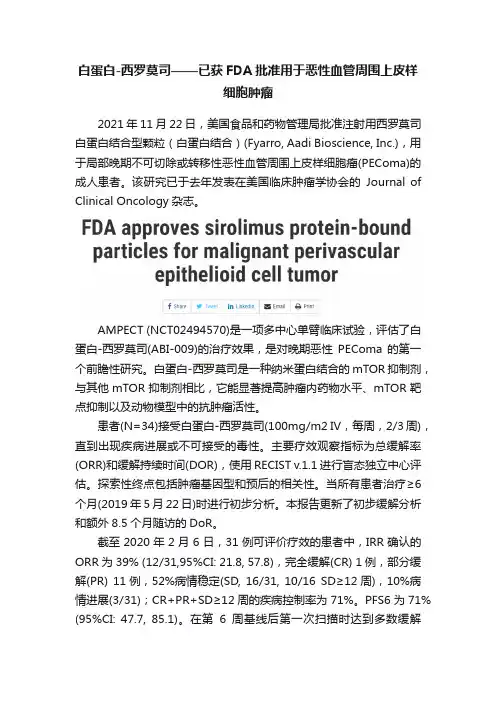
白蛋白-西罗莫司——已获FDA批准用于恶性血管周围上皮样细胞肿瘤2021年11月22日,美国食品和药物管理局批准注射用西罗莫司白蛋白结合型颗粒(白蛋白结合)(Fyarro, Aadi Bioscience, Inc.),用于局部晚期不可切除或转移性恶性血管周围上皮样细胞瘤(PEComa)的成人患者。
该研究已于去年发表在美国临床肿瘤学协会的Journal of Clinical Oncology杂志。
AMPECT (NCT02494570)是一项多中心单臂临床试验,评估了白蛋白-西罗莫司(ABI-009)的治疗效果,是对晚期恶性PEComa的第一个前瞻性研究。
白蛋白-西罗莫司是一种纳米蛋白结合的mTOR抑制剂,与其他mTOR抑制剂相比,它能显著提高肿瘤内药物水平、mTOR靶点抑制以及动物模型中的抗肿瘤活性。
患者(N=34)接受白蛋白-西罗莫司(100mg/m2 IV,每周,2/3周),直到出现疾病进展或不可接受的毒性。
主要疗效观察指标为总缓解率(ORR)和缓解持续时间(DOR),使用RECIST v.1.1进行盲态独立中心评估。
探索性终点包括肿瘤基因型和预后的相关性。
当所有患者治疗≥6个月(2019年5月22日)时进行初步分析。
本报告更新了初步缓解分析和额外8.5个月随访的DoR。
截至2020年2月6日,31例可评价疗效的患者中,IRR确认的ORR为39% (12/31,95%CI: 21.8, 57.8),完全缓解(CR) 1例,部分缓解(PR) 11例,52%病情稳定(SD, 16/31, 10/16 SD≥12周),10%病情进展(3/31);CR+PR+SD≥12周的疾病控制率为71%。
PFS6为71% (95%CI: 47.7, 85.1)。
在第6周基线后第一次扫描时达到多数缓解(67%),中位缓解时间为1.4个月(95%CI: 1.3 ~ 2.8)。
IRR的中位DoR 尚未达到(范围5.6-38.7+个月;计算中位数为22.2+月),其中8/12(67%)缓解持续时间超过1年,5/12(42%)缓解持续时间超过2年。
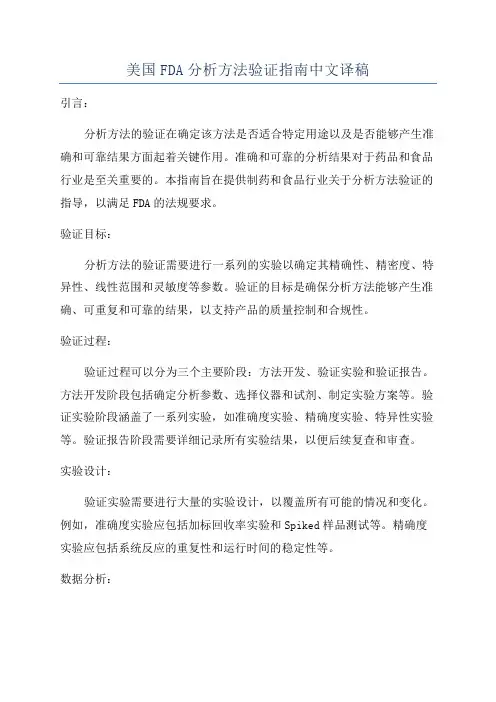
美国FDA分析方法验证指南中文译稿引言:分析方法的验证在确定该方法是否适合特定用途以及是否能够产生准确和可靠结果方面起着关键作用。
准确和可靠的分析结果对于药品和食品行业是至关重要的。
本指南旨在提供制药和食品行业关于分析方法验证的指导,以满足FDA的法规要求。
验证目标:分析方法的验证需要进行一系列的实验以确定其精确性、精密度、特异性、线性范围和灵敏度等参数。
验证的目标是确保分析方法能够产生准确、可重复和可靠的结果,以支持产品的质量控制和合规性。
验证过程:验证过程可以分为三个主要阶段:方法开发、验证实验和验证报告。
方法开发阶段包括确定分析参数、选择仪器和试剂、制定实验方案等。
验证实验阶段涵盖了一系列实验,如准确度实验、精确度实验、特异性实验等。
验证报告阶段需要详细记录所有实验结果,以便后续复查和审查。
实验设计:验证实验需要进行大量的实验设计,以覆盖所有可能的情况和变化。
例如,准确度实验应包括加标回收率实验和Spiked样品测试等。
精确度实验应包括系统反应的重复性和运行时间的稳定性等。
数据分析:验证实验收集到的数据需要进行统计分析,以确定分析方法的可信度。
数据分析应包括数学计算、图表绘制和合规性评估等。
分析结果应该足够准确和可靠,以支持产品的质量控制和合规性。
验证报告:验证报告是验证过程的最终产物,它需要详细记录实验设计、数据分析和结论等信息。
验证报告应包括验证实验的目的、方法、结果和结论等内容。
验证报告需要通过内部审查和外部审查,确保其准确性和可靠性。
结论:美国FDA的《分析方法验证指南》为制药和食品行业提供了详细的指导,以确保分析方法的有效性和可靠性。
通过正确进行方法的验证,可以保证分析结果的准确性,从而支持产品的质量控制和合规性。
制药和食品企业应密切遵循该指南,以便符合FDA的法规要求。
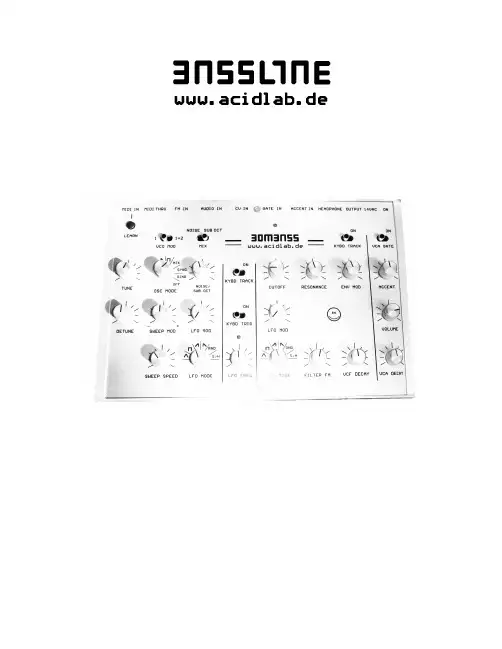
Bombass is a monophonic, analogue synthesizer.The schematics of the VCF, VCA and the envelops are similar to the TB-303, with a lot of new features.With Midi, the pitch, length, slide and accent are controlled.It si also possible to controll the bombass with the inputs CV In, Gate In and Accent In from the sequencer ot the Bassline. The Bombass works then as the synthesizer-section of the Bassline, with much more sound variations, than known from TB-303 modifications.Everything, from abstract filter-sweeps to percussion-sounds is possible.In comparision to the Bassline or the TB-303, the resonance range is extended, that the filter can be played without the VCO.To get an idea about the possibilities of the sound-generation of the Bombass, it is best, to take a look on the block-diagram!Midi-InterfaceMidi connectionBombass must be connected with a Midi-cable on its Midi In, to the Midi Out of the Midi-master (Midi-sequencer, laptop, …).Midi Thru gives the Midi-informations of the Midi-master to further Midi-slaves.Set the Midi-channelPush the Midi-Learn buttom for at least two seconds, then the LED on the top flashs. The next received Midi-note defines the Midi-channel. To change the Midi-channel, the Midi-lLearn buttom must be pushed again.Note length - GateThe Midi-note on/off`s received by the Midi-interface are converted to a gate-signal. Tis is indicated by the LED on the top.Velocity values of `0´ are equal to a note-off and reset the gate-signal.A Midi-stop is equal to an `all-notes-off´, and stops all notes.Pitch - CVThe Midi-information of the pitch is converted to a controll-voltage CV (0-5 Volt;`C´=65,4 Hz).SlideWhen a second Midi-note is received, while the first is playing, the Slide-function is activated.The pitch changes to the new pitch of the second note.AccentVelocity values higher than 99 activate the Accent.The Accent is finished with the Midi-note off.InputsAudio InAudio in (6.3 mm, mono) is an audio input, that is mixed to the audio signal path before the filter.FM InFM in is an input (3.5 mm of mono) to modulates the cutoff frequency of the filter. The FM input is suitable, to modulate the filter with audio signals.CV-, Gate- und Accent-Inputs:With the CV In, Gate In and Accent In (3,5 mm mono), it is possible to controll the Bombass with a sequencer of the Bassline, a TB-303 or any other sequencer that has CV/Gate Out.The internal connections between the Midi-interface and the synthesizer are opened, when these inputs are connected.CV InThe CV In converts 1V/octave to the pitch.Gate InThe Gate In needs a 5-12 Volt signal to controll the note-length.Accent InThe Accent In needs a 5-12 Volt signal to controll the accent-length.The Accent In is normally controlled with the Accent Out of a Bassline, to play its lines, with the extended sound variations of the Bombass.OutputsAudio Outputs:Output is the main output (6,3 mm of mono), to connect a mixer. Headphones is a headphone output (3.5 mm stereo).Both Outputs are controlled with volume.The produced bass frequencies are a large load for following amplifiers and loudspeakers.Without protection they can take damage!Voltage SupplyThe bassline can be operated only with the provided AC power plug(14VAC/300mA).Do not use other power plug!The bassline has an on/off switch on the right back panel.Spare power plugs can bought at acidlab, or directly at Conrad electronics under the part number: 510003-12 .In the USA or at 115VAC nets, you need the power plug of with the part number: 507-XT1620 .WarrantyThe manufacturer grants a warranty of two years starting from the purchase date on the product, in accordance with the condition described here. If defects are founded within this time, then these will be repaired. Potentiometers, switches and sockets apply with this product are excluded from this regulation. The decision over the warranty claim meets the manufacturer. When determined foreign modifications or mechanical damages any warranty claim expires. Products without warranty authorization are liable to pay the costs repaired. In order to clarify the warranty claim, the manufacturer is to be contacted in each case before sending back. Except the manufacturer, no third is justified to assure or implement guaranteeings. Within the warranty term the warranty is transferable to further buyers. Further requirements because of consequential damages are impossible.acidlabDipl. Ing. (FH) Klaus Süßmuthe-mail: *******************web: www.acidlab.de。
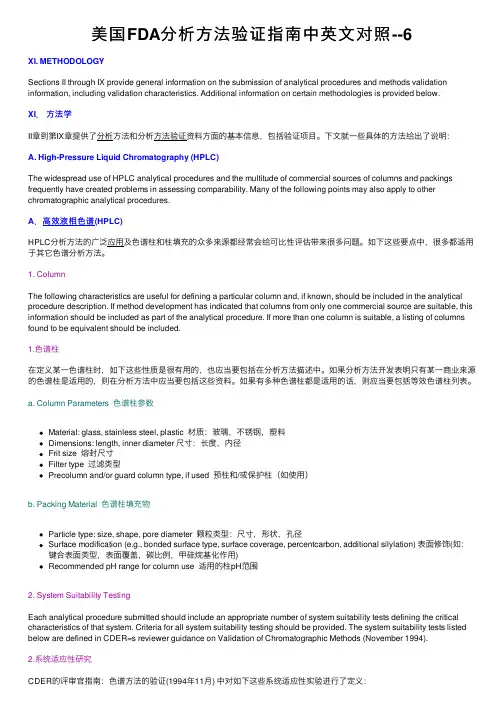
美国FDA分析⽅法验证指南中英⽂对照--6XI. METHODOLOGYSections II through IX provide general information on the submission of analytical procedures and methods validation information, including validation characteristics. Additional information on certain methodologies is provided below.XI.⽅法学II章到第IX章提供了分析⽅法和分析⽅法验证资料⽅⾯的基本信息,包括验证项⽬。
下⽂就⼀些具体的⽅法给出了说明:A. High-Pressure Liquid Chromatography (HPLC)The widespread use of HPLC analytical procedures and the multitude of commercial sources of columns and packings frequently have created problems in assessing comparability. Many of the following points may also apply to other chromatographic analytical procedures.⾊谱(HPLC)⾼效液相⾊谱A.⾼效液相HPLC分析⽅法的⼴泛应⽤及⾊谱柱和柱填充的众多来源都经常会给可⽐性评估带来很多问题。
如下这些要点中,很多都适⽤于其它⾊谱分析⽅法。
1. ColumnThe following characteristics are useful for defining a particular column and, if known, should be included in the analytical procedure description. If method development has indicated that columns from only one commercial source are suitable, this information should be included as part of the analytical procedure. If more than one column is suitable, a listing of columns found to be equivalent should be included.1.⾊谱柱在定义某⼀⾊谱柱时,如下这些性质是很有⽤的,也应当要包括在分析⽅法描述中。
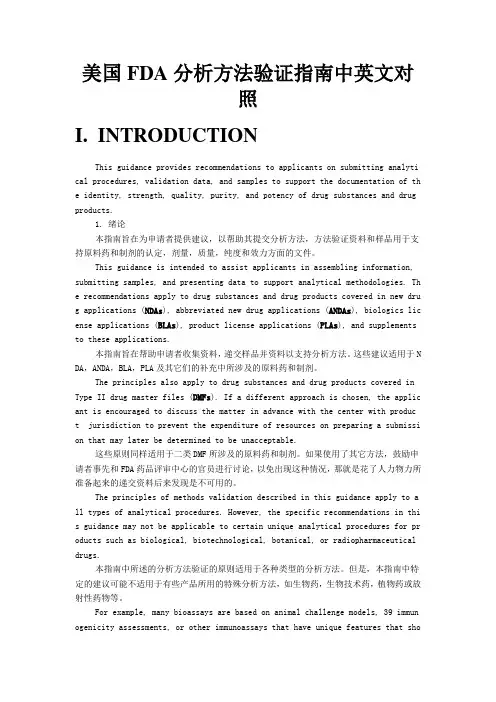
美国FDA分析方法验证指南中英文对照I. INTRODUCTIONThis guidance provides recommendations to applicants on submitting analyti cal procedures, validation data, and samples to support the documentation of th e identity, strength, quality, purity, and potency of drug substances and drug products.1. 绪论本指南旨在为申请者提供建议,以帮助其提交分析方法,方法验证资料和样品用于支持原料药和制剂的认定,剂量,质量,纯度和效力方面的文件。
This guidance is intended to assist applicants in assembling information, submitting samples, and presenting data to support analytical methodologies. Th e recommendations apply to drug substances and drug products covered in new dru g applications (NDAs), abbreviated new drug applications (ANDAs), biologics lic ense applications (BLAs), product license applications (PLAs), and supplements to these applications.本指南旨在帮助申请者收集资料,递交样品并资料以支持分析方法。
这些建议适用于N DA,ANDA,BLA,PLA及其它们的补充中所涉及的原料药和制剂。
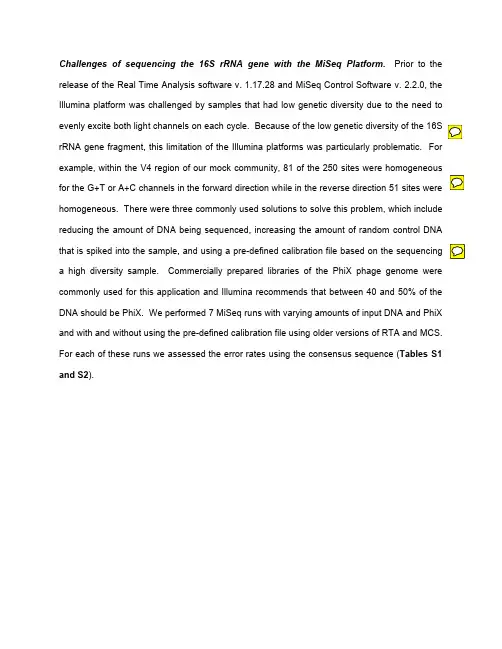
Challenges of sequencing the 16S rRNA gene with the MiSeq Platform.Prior to the release of the Real Time Analysis software v. 1.17.28 and MiSeq Control Software v. 2.2.0, the Illumina platform was challenged by samples that had low genetic diversity due to the need to evenly excite both light channels on each cycle. Because of the low genetic diversity of the 16SrRNA gene fragment, this limitation of the Illumina platforms was particularly problematic. For example, within the V4 region of our mock community, 81 of the 250 sites were homogeneousfor the G+T or A+C channels in the forward direction while in the reverse direction 51 sites were homogeneous. There were three commonly used solutions to solve this problem, which include reducing the amount of DNA being sequenced, increasing the amount of random control DNAthat is spiked into the sample, and using a pre-defined calibration file based on the sequencing a high diversity sample. Commercially prepared libraries of the PhiX phage genome were commonly used for this application and Illumina recommends that between 40 and 50% of the DNA should be PhiX. We performed 7 MiSeq runs with varying amounts of input DNA and PhiX and with and without using the pre-defined calibration file using older versions of RTA and MCS. For each of these runs we assessed the error rates using the consensus sequence (Tables S1 and S2).Table S1. Summary of operating conditions for various MiSeq sequencing runs and machine reported quality metrics. Shaded cells indicate the seven runs that were performed prior to the development of RTA and MCS software, which significantly reduced the amount of PhiX required to obtain high quality sequence data.RunRTAversionMCSversion[DNA](pM)Clusterdensity(K/mm2)%PhiXCorrection%>=Q30Reportedmachineerror (%)16S rRNApairs (106)121203 1.16.18 2.0.5 9 743 49.6 Adaptive 57.0 2.94 5.6 121205 1.16.18 2.0.5 8 607 59.9 Adaptive 64.5 1.37 3.9 121207 1.16.18 2.0.5 6 567 59.2 Adaptive 63.3 1.50 3.7 130125 1.17.22 2.1.13 4 192 82.8 Adaptive 94.4 0.61 0.4 130211 1.17.22 2.1.13 4 387 68.9 Hardcoded 92.0 0.59 1.9 130220 1.17.22 2.1.13 10 702 58.8 Hardcoded 93.9 0.87 4.5 130306 1.17.22 2.1.13 10 781 42.3 Hardcoded 78.9 0.96 4.6 130401 1.17.28 2.2.0 10 1313 3.8 Adaptive 63.7 1.31 12.6 130403 1.17.28 2.2.0 5 1094 3.2 Adaptive 70.5 0.89 12.4 130417 1.17.28 2.2.0 3 839 6.2 Adaptive 74.6 0.92 10.5 130422 1.17.28 2.2.0 1.8 690 8.0 Adaptive 80.1 0.65 9.0Table S2. Summary of the error rates and number of observed OTUs for the sequencing runs described in Table S1. Shaded cells indicate the seven runs that were performed prior to the development of RTA and MCS software, which significantly reduced the amount of PhiX required to obtain high quality sequence data.Region RunError rates (%) % Readsremainingfrom BasicAverage number of OTUs ABasic ΔQ=6Pre-clusterMock B Mock C Soil Mouse HumanV34 121203 2.10 2.50 2.340.5 ND ND ND ND ND 121205 1.95 0.65 0.51 1.5 ND ND ND ND ND121207 1.85 0.73 0.57 1.0 ND ND 1,233.6 ND ND130125 0.30 0.11 0.04 64.9 ND ND 1,101.0 ND 151.0130211 0.54 0.24 0.11 57.5 36.3 47.4 1,078.1 154.4 164.3130220 0.78 0.23 0.11 41.8 34.9 49.5 1,050.2 157.9 154.3130306 0.96 0.26 0.13 27.5 36.5 53.0 1,102.1 175.2 138.7130401 2.14 0.37 0.21 10.3 26.9 49.6 1,110.6 175.1 187.5130403 1.30 0.26 0.12 27.6 31.1 47.8 1,095.8 158.2 164.1130417 1.12 0.24 0.10 27.9 35.1 52.2 1,038.6 ND 142.6130422 0.91 0.29 0.17 47.5 41.4 54.3 1,053.0 162.5 145.1 V4 121203 0.36 0.07 0.01 68.1 21.9 33.2 1,273.9 135.7 123.5 121205 0.29 0.05 0.01 76.5 21.7 33.1 1,278.5 135.4 121.4121207 0.25 0.04 0.01 79.6 21.5 32.3 1,271.9 135.6 121.8130125 0.07 0.03 0.01 97.1 22.1 29.5 1,279.7 136.0 124.2130211 0.09 0.03 0.01 94.7 21.8 32.4 1,274.8 134.2 122.3130220 0.20 0.04 0.01 85.6 21.4 33.6 1,274.3 139.7 122.8130306 0.47 0.05 0.01 70.7 23.4 45.0 1,251.2 141.1 120.8130401 1.08 0.06 0.01 44.2 23.5 43.4 1,248.2 136.1 115.4130403 0.67 0.05 0.01 60.1 23.5 40.9 1,261.8 133.9 117.8130417 0.40 0.05 0.01 69.3 22.8 37.5 1,257.3 135.5 117.2130422 0.28 0.05 0.01 78.4 23.2 37.2 1,256.2 132.8 117.3 V45 121203 2.42 0.570.31 11.1 64.5 85.2 1,181.1 121.5 138.0 121205 2.20 0.72 0.5032.9 144.8 202.6 1,304.2 153.0 243.8121207 1.74 0.57 0.33 34.9 69.4 101.9 1,211.2 142.1 181.2130125 0.47 0.35 0.17 93.1 50.6 60.1 1,301.5 162.2 191.0130211 0.84 0.51 0.30 79.5 85.1 120.0 1,374.1 174.5 193.5130220 1.78 0.74 0.53 57.5 159.1 217.0 1,538.8 204.5 255.4130306 2.62 0.85 0.63 33.7 209.3 275.1 1,582.4 265.8 337.9130401 4.60 0.87 0.64 13.5 191.9 271.7 1,462.8 198.0 312.9130403 3.31 0.79 0.56 32.3 180.4 246.1 1,519.7 213.3 324.0130417 2.38 0.66 0.43 36.5 110.8 158.3 ND 180.4 242.1130422 1.67 0.58 0.36 56.4 98.0 131.6 1,403.3 186.3 227.2A The average number of OTUs is based on rarefaction of each sample to 5,000 sequencesper sample; cells labeled as ND reflect samples that did not have at least one replicate with more than 5,000 sequences.B Number of OTUs in the mock community when all chimeras were removed; in the absenceof chimeras and sequencing errors, there should be 20 OTUs for all three regions.C Number of OTUs in the mock community when chimeras were removed using UCHIME.Standard Author James KozichOperating Effective Date 20-May-13Procedure Site Ann Arbor Title: 16S Sequencing with the Illumina MiSeq Personal SequencerDetailed Title Library Generation, QC, Sequencing, and Data Quality AnalysisProceduresOriginal Date 25-Mar-13Additional Authors Patrick SchlossVersion 2.0Last Updated 20-May-13Updated By James Kozich1.0) Aim/Rationale of Protocol•The Purpose of this protocol is to define the steps and costs in both material and man hours for the preparation and sequencing of 16S libraries using the Illumina MiSeq in the laboratory of Dr.Patrick Schloss Ph.D., Department of Microbiology and Immunology.2.0) Introduction and Workflow2.1) Introduction•The Illumina MiSeq Personal Sequencer can produce 2 x 250 paired-end reads and up to 15 Gb of data in a single run. Dual indexing of library samples allows up to 384 samples to be runsimultaneously. The instrument is capable of producing in excess of 15 million pairs of reads, however, for low diversity runs about 12 million reads can be expected. A wide range ofapplications is possible including 16S analysis, metagenomics, genome sequencing,transcriptomics, and RNA sequencing.•There are several steps in preparing samples for sequencing on the MiSeq. Broadly, these include library generation and indexing, quality control, normalization and pooling, quantification, sequencing, run quality assessment, and data export.2.2) 16S Prep Workflow1.for controls. Plate used should be compatible with Eppendorf epMotion 5075.2. The investigator will provide the technician with the names of the project, experiment, a one-sentence description of the experiment, a name for each plate submitted (up to 4 96 well plates per run), the names and groupings of each sample.3. A Sample Plate will then be created for each plate using Illumina Experiment Manager. SamplePlates will then be used to create a Sample Sheet. This sheet serves as the set of runparameters and indexing scheme used by the MiSeq for the run.4.Each plate will contain a negative control (water) and a positive control (mock community).5.ensure amplification proceeded normally.6. Library clean up and normalization performed using the Invitrogen SequalPrep PlateNormalization Kit.7. Samples from all plates are pooled.8. Library QC includes quantification using a KAPA Biosystems Q-PCR kit cat# KK4824, andobtaining a Bioanalyzer trace using the Agilent Technologies HS DNA kit cat# 5067-4626.9. Library enters the Sequencing Workflow.2.3) Sequencing Workflow1. The technician will review all documentation including the sample sheet. The sample sheet willbe transferred to the instrument. The Technician will consult with the investigator to choose an appropriate amount of DNA to load for optimal cluster density and ensure optimum dataquality/quantity.2. The reagent cartridge will be thawed in a water bath per the MiSeq User Guide.3. Unless otherwise specified, dilution and loading will follow the steps outlined in the document:Preparing DNA Libraries for Sequencing on the MiSeq (15039740 B)4. Any custom primers required (including those for 16S) will be mixed with the native primers onthe reagent cartridge.5. The technician will load the sample sheet, flow cell, reagent cartridge, PR2 bottle, and an emptywaste bottle onto the MiSeq and start the run. A 500 cycle run takes approx. 44 hours.6. The technician will monitor the run using Illumina Sequence Analysis Viewer.7. The data will be stored on the Schloss Lab NAS drive and made available to the investigatorfollowing run completion. Unless otherwise requested, default output will be fastq files.8. Technician will perform a post run wash and any required maintenance of instrument.3.0) Safety and Waste Disposal• The Schloss Lab Chemical Hygiene Plan should be followed at all times.• Standard PPE (nitrile gloves, safety glasses, and lab coat) should be used at all times.• Each reagent cartridge contains a small amount of formamide and must be disposed of in anappropriate container following the run. Liquid waste from a run must also be disposed of as hazardous due to the formamide content.• All other safety concerns may be addressed to the lab chemical safety officer.4.0) ConsumablesReagent/KitCatalog # Price MiSeq® Reagent Kit v2 (500 cycle) MS-102-2003 $910.80 PhiX Control Kit v3FC-110-3001 $132.00 16s Index Primers (40 total)IDT $1180.00 16s Sequencing Primers (Read 1, Index, Read 2) IDT41.71 AccuPrime™ Pfx SuperMix 200rxns 12344-040 $331.28 Agilent High Sensitivity DNA Kit5067-4626 $434.70 Library Quantification Kit - Illumina/Universal KK4824 $575.00 SequalPrep™ Normalization Plate (96) KitA10510-01 $453.60 epT.I.P.S. Motion 1-50 µL Reloads 24 racks of 96 tips 30014421 $190.00 Tip One Refill Wafers 200µL elongated graduated NC9549602 $39.24 Tip One Refill Wafers 1000µL graduated 1111-2721$25.25 Fisher 1N NaOH 1LSS266-1 $46.32 TWIN.TEC 96 Well Plate Skirted BlueE951020460 $99.235.0) Run CostsFor 384 sample run PCR and Indexing Cleanup Pooling &Normalization LibraryQC Sequencing Totals Total Cost with Man Hours Duration (days) 16SReagents $588 $265 $138 $941 $1932 $2,2324.5 days16S Man hours 4344156.0) Method(s)6.1) Published Protocols•The following methods and references are used in the workflows above.o MiSeq User Guide Rev. Ho Preparing DNA Libraries for Sequencing on the MiSeq (15039740 B)o Kapa Biosystems Q-PCR Library Quantification Kit Illuminao Accuprime Pfx Super Mixo Agilent High Sensitivity DNA Kit Guideo SequalPrep Normalization Plate (96) Kit6.2) Working Protocols• A Detailed protocol for the 16S workflow can be found in Appendix A.7.0) Data Analysis7.1) During Run•The Technician will monitor the run using Illumina Sequence Analysis Viewer.•To asses run quality, the technician will review the following data: cluster density, clusters passing filter, data yield, Q30 Score, intensity, corrected intensity, % base composition, %aligned, reads, reads passing filter, and indices identified following index reads.•The tolerances for the preceding data are run type dependent. The investigator will consult the technician prior to the run to determine these values.7.2) Post Run•The default repository for run data is the “runs” folder on the Schloss Lab NAS Drive.•Investigators wishing for personal copies of fastq files must provide the technician with storage media.•The investigator will determine whether sufficient coverage and quality have been achieved or if there is a need for re-sequencing, and notify the technician immediately.•It is recommended that investigators use mothur for fastq analysis.Written By:_________________________________________________ Date: ________________Reviewed and Approved By:___________________________________ Date: ________________New VersionDate ChangeReason for Change 1.0 3/18/2013 SOP CreatedN/A2.05/16/2013 Note about software update added to Appendix B.Updated linked Illumina Documents to currentversions section 2.3 and 6.1. Removed Ampure link section 6.1. Updated consumables to reflect newprices and added pcr plates section 4.0. Adjustedman-hours calculations and run cost section 5.0. Eliminate Hardcoding language section 2.3.5.Corrected nM to µM Appendix A Initial Set Up lines 1 and 2, added reference to Appendix B, and eliminated hardcoding language substituting with current guidelines line 7. Under Appendix A PCR Program changes penultimate step to 72C 10:00. Appendix A Sequencing removed former line 3, which was a check to ensure hardcoding was in use; line 9 edited to reflect current NaOH practice; line 11 edited to reflect changes resulting from software update. Section 7.1 bullet 2 added reads and reads passing filter. Section 7.2 bullet 3 added note about technician notification. Appendix A CleanupNormalization and Pooling line 8 changed to create pool from each plate. Use 5µl instead of 3µl.Appendix A Library QC line 1 eliminated 1:20 and 1:40 dilutions, changed to “each” pool; line 2j adjusted to load 4 plate pools on Bioanalyzer chip, line 3ki added “from Bioanalyzer”, and added line 4. Appendix A Run Monitoring line 2 eliminated hardcoding language and adjusted expectedparameters reflecting lower PhiX. Removed % base composition target.MiSeq software update, general corrections, newprice quotes. 8.0) Change Control 9.0) Signature BlockAppendix ADetailed 16S ProtocolInitial Set up1. Reconstitute indexed primers to 100 µM. See Appendix D for primer design.2. Prepare 100µl 10 µM aliquots of indexed primers.3. Array aliquots into four 96 well plates. Use the following scheme:a. A701 – A712 with A501 – A508b. A701 – A712 with B501 – B508c. B701 – B712 with B501 – B508d. B701 – B712 with A501 – A5084. Extract template DNA and array in 96 well format leaving two wells open. (One for anegative water control and another for the positive Mock Community control)5. Using Illumina Experiment Manager, create a sample plate for each 96 well plate oftemplate. Choose indexes that correspond to one of the four index pair plates above. SeeAppendix C for instruction on creating a custom assay in IEM.6. Using Illumina Experiment Manager, create a sample sheet for the run. Ensure that indexchoices are compatible with one another and there is sufficient diversity in the index readsso as to activate both light channels every cycle.7. The MiSeq requires base diversity on every cycle. 16S is a low diversity library. With MiSeqsoftware v2.2, 16S libraries can be loaded with 5% PhiX. Additionally, other high diversitysamples such as metagenomes can be run simultaneously. This requires manually editingthe sample sheet. Older software versions required “hardcoding” the matrix andphasing/pre-phasing values. See Appendix B.PCRNote: These steps may be performed using an epMotion or similar automated pipetting system.1.Dispense 17 µl of Accuprime Pfx Supermix into each well of a new 96 well plate.ing a multichannel pipette, transfer 1 µl of template DNA per well to the correspondingwell on the PCR plate.ing a multichannel pipette, transfer 2 µl of each paired set of index primers to thecorresponding well on the PCR plate. Be sure to follow the layout chosen in the samplesheet.4.Add 1 µl of PCR grade dH2O to the negative control well, and 1 µl of Mock Community at a1:3 dilution to the positive control well.5.Repeat for up to four 96 well plates. Seal plates, vortex briefly and spin down contents.6.Place in thermocycler.PCR ProgramUse the following program:95C 2:00--------30 cycles--------95C 00:2055C 00:1572C 5:00----------------------------72C 10:004C endGel Electrophoresis1.success of the PCR.2. Use 2 µl of sample, 4 µl of loading dye in a 1% agarose gel.3. Run at 100v for 30 minutes alongside a standard ladder.4. Photograph gel under UV. Check to be sure there is a band for every well.Cleanup, Normalization, and PoolingUse the SequalPrep Normalization Plate Kit1. Transfer 18 µl of PCR product from PCR plate to corresponding well on the normalizationplate.2. Add 18 µl of Binding Buffer. Mix by pipetting, sealing, vortexing, and spinning briefly.3. Incubate at room temperature for 60 minutes. Note: can incubate overnight if needed. Extratime does not improve results.4. Aspirate the liquid from the wells. Do not scrape the sides.5. Add 50 µl of Wash Buffer and pipette up and down twice, then aspirate immediately. Ensurethere is no residual wash buffer in any wells.6. Add 20 µl of Elution Buffer. Mix by pipetting up and down 5 times. Seal, vortex, and spinbriefly.7. Incubate at room temperature for 5 minutes.8. Create a pool from each plate. Take 5 µl of each well to pool. The use of an empty 96 wellplate may facilitate the use of multichannel pipettes.9. Freeze the remaining sample for later use.Library QC1. Prepare the following dilutions of each pooled library in PCR grade H2O:a. 1:1b. 1:10c. 1:1000 (dilute in several steps for better results)d. 1:2000e. 1:40002. Agilent Bioanalyzer Tracea. Prepare Gel-Dye mix if not already prepared.b. Let reagents equilibrate to room temperature.c. Turn Bioanalyzer on and load 350 µl of dH2O onto electrode cleanser and place inanalyzer for 5 minutes.d. Open a high sensitivity chip and place on the priming station. Base plate should be aposition “C” and syringe clip should be at lowest position.e. Load 9.0 µl of gel-dye mix to position 12 market with a large “G”. Ensure the syringeplunger is at 1.0 ml and close the station. Press plunger until it is held by clip.f. Wait for exactly 60 seconds then release the plunger clip. Wait an additional 5seconds, then slowly pull the plunger back to the 1.0 ml position.g. Open the priming station. Pipette 9.0 µl of gel-dye mix into the other wells marked“G” in positions 4,8,and 16.h. Pipette 5.0 µl of marker to all wells excluding the right column. (No marker positions4,8,12, and 16)i. Load 1 µl of ladder into position 15 marked by the ladder symbol.j. Pipette 1 µl of each of dilutions a – b above. Top row Plate 1 Pool 1:1 x 1, 1:10 x 2.Second row Plate 2 pool 1:1 x 1, 1:10 x 2. Third row Plate 3 Pool 1:1 x 1, 1:10 x 2.Bottom row Plate 4 Pool 1:1 x 1, 1:10 x 2.k. Place chip in the designated vortex for 1 minute, then transfer chip to the Bioanalyzer.l. Open the 2100 Expert software and select the HS DNA Assay. Enter sample names/dilutions for each of the test wells. Click Start.m. Print .pdf when run finishes.3. Kapa Q-PCR Library Quantificationa. Before Q-PCR reaction setup, add 1 ml Primer Premix (10X) to the 5 ml bottle ofKAPA SYBR® FAST Q-PCR Master Mix (2X) and mix by vortexing for 10 sec.Record the date of Primer Premix addition on the KAPA SYBR® FAST Q-PCRMaster Mix bottle.b. Reaction can be either 10 µl or 20 µl. A 10 µl reaction volume is recommended.c. Prepare a 96 well Q-PCR plate compatible with the real time thermocycler. Thereare six standards. Each should be run in triplicate. Each pool at each dilution shouldbe run in triplicate.d. For 10 µl reaction volume dispense 6 µl of master mix into each well needed.e. Pipette 4 µl of standards and library dilutions into appropriate wells. Mix by pipetting.Vortex and spin optional.f. Place plate in thermocycler. Start control softwareg. Program the following cyclei. Initial Activation 95 °C 5 minutesii. 35 cycles1. Denaturation 95 °C 30 seconds2. Annealing 60 °C 45 seconds3. If library fragment size exceeds 700bp, extend annealing step to 90seconds.iii. Perform melt curve to check for primer/adaptor dimerh. Assign wells and group replicates.i. Enter values for standardsi. Std. 1 20pMii. Std. 2 2pMiii. Std. 3 0.2pMiv. Std. 4 0.02pMv. Std. 5 0.002pMvi. Std. 6 0.0002pMvii. Note: The concentrations provided here are for the DNA Standards assupplied in the kit, and are NOT the concentrations in the reactions. Providedthat the volume of template added to each reaction is the same for Standardsand for library samples (i.e. 4 µl in each case), there is no need to account forthese volumes when calculating the concentrations of library samples, norshould one need to calculate the concentration of template in the reaction.j. Run programk. To calculate library concentration use the following formula:i. Average x (452/Avg fragment length from bioanalyzer) x dilution factorii. Use the average of the triplicate data points corresponding to the mostconcentrated library DNA dilution that falls within the dynamic range of theDNA Standards to calculate the concentration of the undiluted library.iii. Do not include outliers in calculation. If there is more than one outlier in agroup, the assay must be repeated.4. Create normalized pools from each plate by diluting to the concentration of the leastconcentrated plate. Create a single final pool by adding equal amounts of each post qpcrnormalized pool. Final pool must be >10µl in total volume. 40-80µl is ideal.Sequencing1. Remove a 500 cycle reagent cartridge from the -20 °C freezer. Place in room temperaturewater bath for one hour. Place HT1 buffer tube in 4 °C fridge.2. Copy sample sheet to sample sheet folder on MiSeq. Rename sample sheet to matchbarcode of reagent cartridge.3. When the reagent cartridge has thawed, dry bottom with paper towel. Invert the cartridgerepeatedly to check each well is thawed. This also serves to mix the reagents. Place inhood.4. Thaw library, PhiX, and sequencing primers. Check to make sure HT1 is thawed.5. Place 3 µl of the Read 1 Sequencing Primer(s) into a clean PCR tube. Repeat in separatetubes for the Index Primer(s) and Read 2 Sequencing Primer(s).6. Using a 1000 µl pipette tip, break the foil over wells 12, 13, 14, and 17.7. Use an extra long 100 µl tip with the pipettor set on 75 µl to transfer the 3 µl of Read 1Sequencing Primer to the bottom of well 12 and pipette 10X to mix. Repeat this processspiking the Index Primer into well 13 and the Read 2 Sequencing Primer into well 14.8. Prepare a fresh dilution of 0.2N NaOH.9. To a 1.5ml tube add 10 µl of library, and 10 µl of 0.2N NaOH. To a separate tube add 2 µlPhiX, 3 µl PCR grade water, and 5 µl of 0.2N NaOH. Vortex both tubes to mix and spin for 1minute at 400rcf. Note: NaOH concentration on the flow cell must remain under 0.001N.Adjusting the concentration of the NaOH used to denature the DNA to 0.1N may benecessary.10. Allow the tubes to incubate at room temperature for 5 minutes. Immediately add 980 µl ofHT1 to the library tube, and 990 µl HT1 to the PhiX tube.11. Use HT1 to dilute both the library and PhiX to 10pM. For a 5% PhiX run, combine 950 µl of3.5pM Library and 50 µl PhiX in a final tube. Vortex. Load 600 µl of this solution into well 17on the reagent cartridge. See example below:a. (1.45 nM library x 10 µl) + (0.2N NaOH x 10 µl) + 980 µl HT1 = 14.5pM Lib, 0.002NNaOHb. (14.5pM lib x 241.38 µl) + 758.62 µl HT1 = 3.5pM lib, 0.00048N NaOHc. [(10nM PhiX x 2 µl) + 3 µl H2O] + (0.2N NaOH x 5 µl) + 990 µl HT1 = 20pM PhiX,0.001N NaOHd. (20pM PhiX x 175 µl) + 825 µl HT1 = 3.5pM PhiX, 0.0000175N NaOHe. (3.5pM Lib x 950 µl) + (3.5M PhiX x 50 µl) = solution loadedf. Solution loaded is 3.5pM overall with a 3.325pM Library concentration, 0.175pMPhiX concentration, and 0.0000457N NaOH13. Set reagent cartridge aside. Unbox flow cell and PR2 bottle.14. Thoroughly rinse the flow cell with Milli-Q water. Carefully dry by blotting with lint free wipes(Kimwipes). Give special attention to the edges and points of intersection between the glassand plastic.15. Wet a new wipe with 100% alcohol and wipe the glass on both sides avoiding the rubberintake ports.16. Visually inspect the flow cell to ensure there are no blemishes, particles, or fibers on theglass.17. Follow on screen instructions and load the flow cell, reagent cartridge, and PR2 bottle.Empty and replace the waste bottle.18. Ensure the machine recognizes the correct sample sheet and the run parameters arecorrect.19. Wait for the MiSeq to perform its pre-run checks, and press start.Run Monitoring1. The run should be monitored periodically using Illumina Sequence Analysis Viewer.2. Ideal parameters for a 95% 16S run:a. Cluster density 700-800k/mm2b. >85% clusters passing filterc. 5% aligned (amount of PhiX)d. No spikes in corrected intensity plote. All indices identified following index readsf. Final >Q30 score of >70%Final Steps1. Perform post run wash.2. Dispose of liquid waste in appropriate hazardous jug and reagent cartridge in hazardousbucket.3. When MiSeq Reporter finishes, copy the fastq files from the analysis folder to the run folderon the NAS drive.4. Perform maintenance wash if required.5. Confirm with investigator that data are of sufficient quality and quantity.Note: The need for hardcoding has been eliminated with the 3/25/2013 release of the MiSeq 2.2 software update package. The changes calculate phasing/pre-phasing values dynamically for each cycle. See the release notes here: MiSeq_v2.2_Software_Release_NotesHardcodingBackgroundWhen sequencing low diversity samples like 16S libraries, the MiSeq can generate unusually high phasing/pre-phasing values. Since the MiSeq is made to run a wide variety of sample types, it attempts to determine these values in the first 12 cycles of each read. High values may lead to a known RTA software glitch called a corrected intensity spike. This manifests as a massive increase in corrected intensity values either in one large spike or in a pattern of exponential growth in amplitude over the course of a read. This causes the MiSeq to either fail outright or generate extremely low Q30 scores and error rates in the 80-100% range. Hardcoding provides the matrix and phasing/pre-phasing values in advance based on an ideal run. In most cases this eliminates the corrected intensity spike issue. Note however, hardcoding is not an officially supported customization.PreparationThe procedure requires a paired end, non-indexed PhiX (or other balanced sample) run to generate the values that will be hardcoded. It is important to ensure that this run is done with the same reagent kit version and software version as your low-diversity samples, and if any major service is done on the instrument, the PhiX run must be performed again, and the values updated. The values are generated in the first 12 cycles, so running 250 cycles in each direction in not necessary. Twenty cycles in each direction should be more than sufficient. Illumina technical support can provide instructions and two versions of the MiSeqConfiguration.xml file. One version is the original, the other contains the framework for hardcoding the values from your PhiX run.ProcedureThe files from Illumina contain a series of instructions, which should be followed with a few alterations.1. In the C:\Illumina\RTA\Configs directory, create a new folder called “alternateconfigurations”. Copy the standard_MiSeqconfiguration.xml andlowdiversity_MiSeqconfiguration.xml from Illumina to this folder. Copies of the matrix andphasing/pre-phasing value files from the PhiX run can be stored here for future reference.2. The low diversity file is not initially set up for a paired end, dual indexed run. It must bemodified. Open the file with the text editor of your choice. Copy the entire block for indexread including the </ArrayofFloat> lines at the beginning and end. Insert a new line betweenthe index read section and the read 2 section. Paste the new section here.3. Additionally, a line must be added to the phasing and pre-phasing sections.4. Use the values from read one for both index reads.Note: The MiSeqconfiguration.xml file must be swapped back to the original if a non-low diversity run is to be performed.。
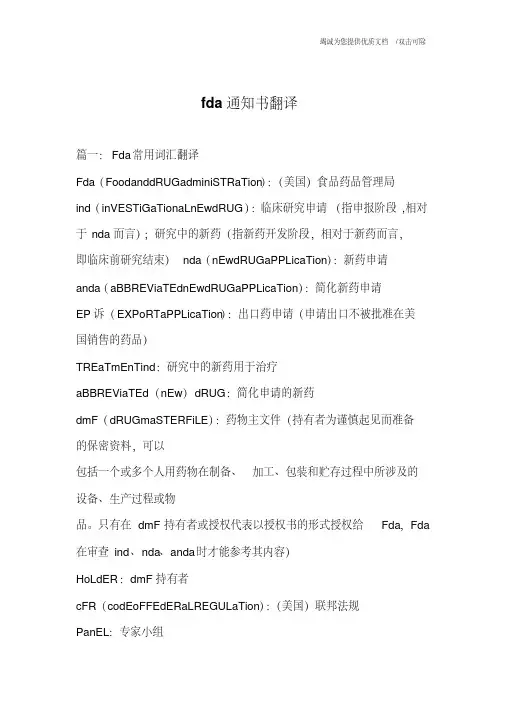
fda通知书翻译篇一:Fda常用词汇翻译Fda(FoodanddRUGadminiSTRaTion):(美国)食品药品管理局ind(inVESTiGaTionaLnEwdRUG):临床研究申请(指申报阶段,相对于nda而言);研究中的新药(指新药开发阶段,相对于新药而言,即临床前研究结束)nda(nEwdRUGaPPLicaTion):新药申请anda(aBBREViaTEdnEwdRUGaPPLicaTion):简化新药申请EP诉(EXPoRTaPPLicaTion):出口药申请(申请出口不被批准在美国销售的药品)TREaTmEnTind:研究中的新药用于治疗aBBREViaTEd(nEw)dRUG:简化申请的新药dmF(dRUGmaSTERFiLE):药物主文件(持有者为谨慎起见而准备的保密资料,可以包括一个或多个人用药物在制备、加工、包装和贮存过程中所涉及的设备、生产过程或物品。
只有在dmF持有者或授权代表以授权书的形式授权给Fda,Fda 在审查ind、nda、anda时才能参考其内容)HoLdER:dmF持有者cFR(codEoFFEdERaLREGULaTion):(美国)联邦法规PanEL:专家小组BaTcHPRodUcTion:批量生产;分批生产BaTcHPRodUcTionREcoRdS:生产批号记录PoST-oRPRE-maRKETSURVEiLLancE:销售前或销售后监督informEdconSEnT:知情同意(患者对治疗或受试者对医疗试验了解后表示同意接受治疗或试验)Fda(FoodanddRUGadminiSTRaTion):(美国)食品药品管理局ind(inVESTiGaTionaLnEwdRUG):临床研究申请(指申报阶段,相对于nda而言);研究中的新药(指新药开发阶段,相对于新药而言,即临床前研究结束)nda(nEwdRUGaPPLicaTion):新药申请anda(aBBREViaTEdnEwdRUGaPPLicaTion):简化新药申请EP诉(EXPoRTaPPLicaTion):出口药申请(申请出口不被批准在美国销售的药品)TREaTmEnTind:研究中的新药用于治疗aBBREViaTEd(nEw)dRUG:简化申请的新药dmF(dRUGmaSTERFiLE):药物主文件(持有者为谨慎起见而准备的保密资料,可以包括一个或多个人用药物在制备、加工、包装和贮存过程中所涉及的设备、生产过程或物品。
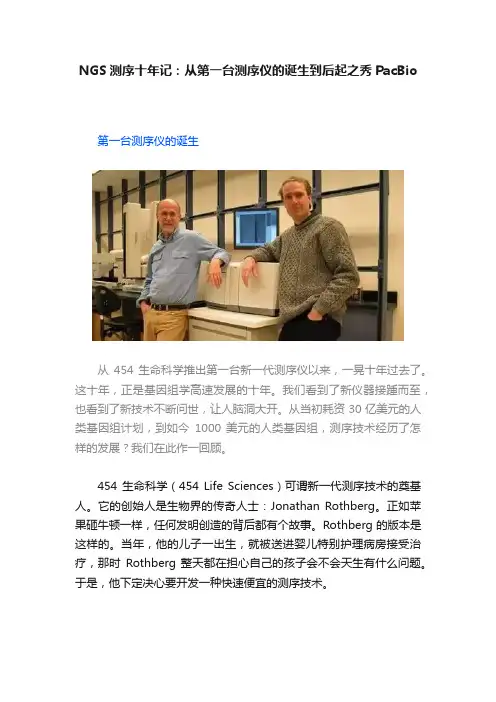
NGS测序十年记:从第一台测序仪的诞生到后起之秀PacBio 第一台测序仪的诞生从454 生命科学推出第一台新一代测序仪以来,一晃十年过去了。
这十年,正是基因组学高速发展的十年。
我们看到了新仪器接踵而至,也看到了新技术不断问世,让人脑洞大开。
从当初耗资 30 亿美元的人类基因组计划,到如今1000 美元的人类基因组,测序技术经历了怎样的发展?我们在此作一回顾。
454 生命科学(454 Life Sciences)可谓新一代测序技术的奠基人。
它的创始人是生物界的传奇人士:Jonathan Rothberg。
正如苹果砸牛顿一样,任何发明创造的背后都有个故事。
Rothberg 的版本是这样的。
当年,他的儿子一出生,就被送进婴儿特别护理病房接受治疗,那时Rothberg 整天都在担心自己的孩子会不会天生有什么问题。
于是,他下定决心要开发一种快速便宜的测序技术。
2005 年,Rothberg 的梦想终于实现了。
454 生命科学等研究人员于7 月在《Nature 》杂志上发表了一篇题为“Genome sequencing in microfabricated high-density picoliter reactors ”的文章,介绍了一种边合成边测序(sequencingby synthesis)的技术,比传统的 Sanger 测序快 100 倍。
这种技术合成 DNA 片段,并将它们分开平行测序,再重新组合成基因组。
它的效果也通过生殖支原体(Mycoplasma genitalium)这种细菌的测序而得到了证明。
在4 小时内,研究人员就完成了测序,且准确性超过99.99% 。
454 的方法之所以引起轰动,不仅是因为这个成果,而是因为它绕过了Sanger 测序的限制,未来有望使测序时间和成本进一步下降。
人类基因组计划的首席科学家 Francis S. Collins 博士对此评价道:“测序技术需要变得更小、更快速、更便宜,才能满足个性化医疗的承诺。
Perspective The NEW ENGLAND JOURNAL of MEDICINEn engl j med nejm.org1This year marks 60 years since James Watson and
Francis Crick described the structure of DNA and 10 years since the complete sequencing of the human genome. Fittingly, today the Food and Drug
Administration (FDA) has granted marketing authorization for the first high-throughput (next-gener-ation) genomic sequencer, Illumi-na’s MiSeqDx, which will allow the development and use of innu-merable new genome-based tests. When a global team of research-ers sequenced that first human genome, it took more than a de-cade and cost hundreds of mil-lions of dollars. Today, because of federal and private investment, sequencing technologies have ad-vanced dramatically, and a human genome can be sequenced in about 24 hours for what is now less than $5,000 (see graph). This is a rare example of technology development in which faster, cheaper, and better have coincid-ed: as costs have plummeted and capacity has increased, the accu-racy of sequencing has substan-tially improved. With the FDA’s announcement, a platform that took nearly a decade to develop from an initial research project funded by the National Institutes of Health will be brought into use for clinical care. Clinicians can selectively look for an almost unlimited number of genetic changes that may be of medical significance. Access to these data opens the door for the trans-formation of research, clinical care, and patient engagement.To see how this technology could be used, consider cancer. Comprehensive analysis of the genome sequence of individual cancers has helped uncover the specific mutations that contribute to the malignant phenotype, iden-tify new targets for therapy, and increase the opportunities for choosing the optimal treatment for each patient. For instance, lung adenocarcinoma can now be divided into subtypes with unique genomic fingerprints associated with different outcomes and dif-ferent responses to particular therapies. More broadly, recent work from the Cancer Genome Atlas demonstrates that the tis-sue of origin of a particular can-cer may be much less relevant to prognosis and response to ther-apy than the array of causative mutations.1 As a result, patients diagnosed with a cancer for which there are few therapeutic options may increasingly benefit from drug therapies originally aimed
First FDA Authorization for Next-Generation SequencerFrancis S. Collins, M.D., Ph.D., and Margaret A. Hamburg, M.D.
The New England Journal of Medicine Downloaded from nejm.org on November 26, 2013. For personal use only. No other uses without permission. Copyright © 2013 Massachusetts Medical Society. All rights reserved. PERSPECTIVEn engl j med nejm.org2at other cancers that share com-mon driver mutations. The new technology allows us go from our current approach of targeted searches for specific mutations in individual cancers to wide-spread use of approaches that survey the entire genome.A major area of opportunity that has yet to be fully exploited is pharmacogenomics — the use of genomic information to iden-tify the right drug at the right dose for each patient. More than 120 FDA-approved drugs have pharmacogenomics information in their labeling, providing im-portant details about differences in response to the drug and, in some cases, recommending ge-netic testing before prescribing.2But the full potential of phar-macogenomics is largely unreal-ized, because of the logistic chal-lenges in obtaining suitable genomic information in a timely enough fashion to guide prescrib-ing. Placing genomic information in the electronic medical record would facilitate this kind of per-sonalized medicine. If the pa-tient’s entire genome were part of his or her medical record, then the complexities of acquir-ing a DNA sample, shipping it, and performing laboratory work would be replaced by a quick electronic query.Although this scenario holds great promise, the utility of ge-nomic information for drug pre-scribing must be documented with rigorous evidence. For ex-ample, three recently published clinical trials raise questions about the clinical utility of using pharmacogenetic information in the initial dosing of vitamin K anatagonists.3 The FDA based its decision to grant marketing authorization for the Illumina instrument platform and reagents on their demon-strated accuracy across numer-ous genomic segments, spanning 19 human chromosomes. Preci-sion and reproducibility across instruments, users, days, and re-agent lots were also demonstrated.The marketing authorization of a sequencing platform for clini-cal use will probably expand the incorporation of genetic informa-tion into health care. But even the most promising technologies cannot fully realize their poten-tial if the relevant policy, legal, and regulatory issues are not ad-equately addressed. Already, key policy advances have helped smooth the way and address many of the public’s concerns about the potential misuse of ge-netic information.4 For example, the Health Insurance Portability and Accountability Act of 1996 (HIPAA) and the Genetic Informa-tion Nondiscrimination Act (GINA) prohibit health insurers from con-sidering genetic information as a preexisting condition, as material to underwriting, or as the basis for denying coverage. GINA also protects against use of genetic information by employers. These protections do not, however, ex-tend to the disease manifesta-tions of genetic risks. Although genomic information showing a predisposition to cancer would be protected under GINA, other clinical signs or symptoms indic-ative of cancer are not protected. Provisions of the Affordable Care Act set to go into effect in 2014 go a step further and will preclude consideration of all preexisting conditions, whether genomic or not, in establishing insurance premiums. Current federal laws, however, do not restrict the use of genomic information in life insurance, long-term care insur-ance, or disability insurance.The legal landscape for the use of genomics in personalized medicine grew brighter in June of this year when the Supreme Court ruled (in Association for Mo-lecular Pathology v. Myriad Genetics) that isolated naturally occurring DNA cannot be patented. This decision was a breakthrough for access to individual genetic tests but also, even more important, for the integration of genome se-quencing into clinical care. Be-fore the Myriad decision, there